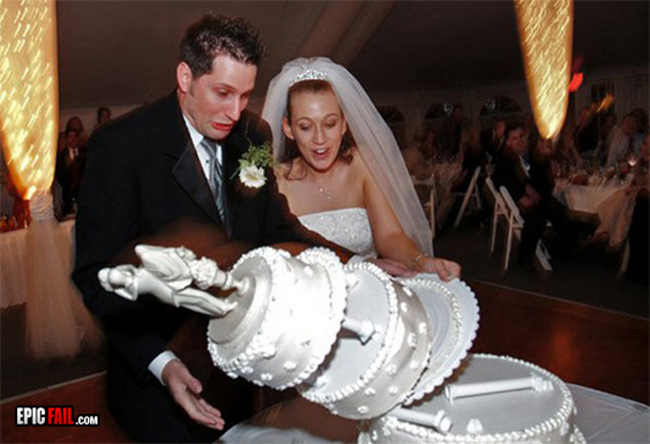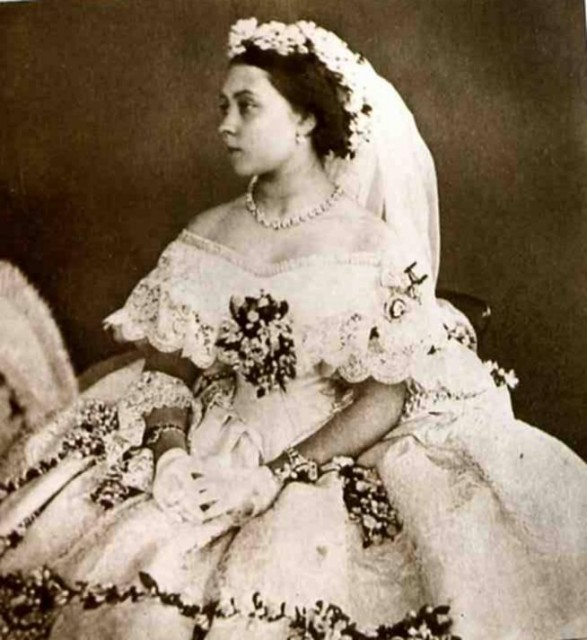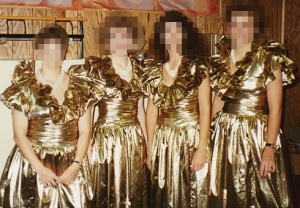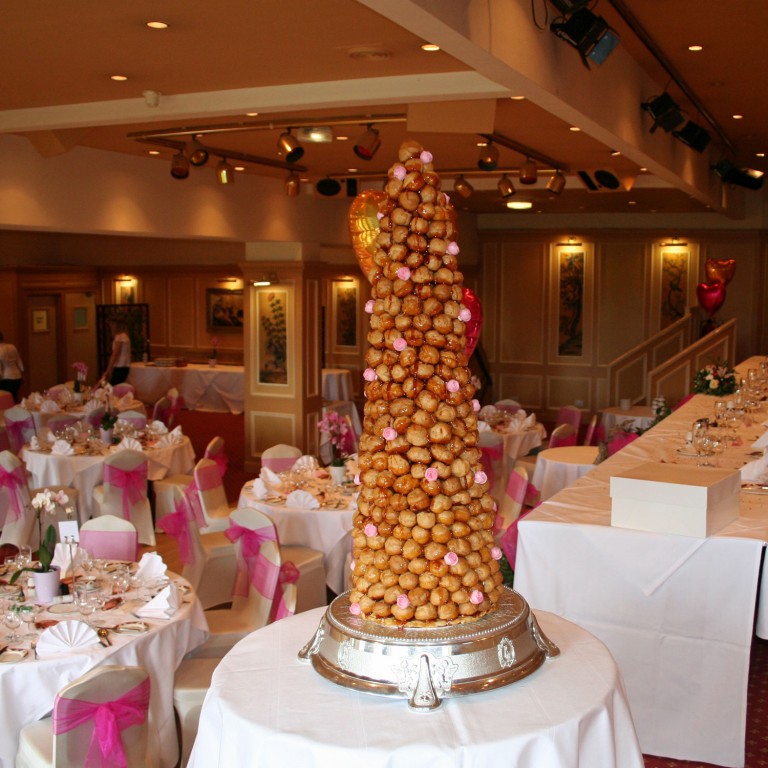11 Wedding & Wedding Cake Historical Trivia Facts


When a bride and groom are in the midst of planning the event for the most important day of their lives, it’s easy to get caught up in the minutiae of meeting everyone’s expectations – whether or not any of them actually make sense or have a logical place in ‘tradition.’ We’ve all been to weddings before – we’ve seen things that we like, that we don’t like, and probably a lot of things perhaps we don’t even understand. But what takes place on a couple’s wedding day should be personal and special and meaningful – to them. Whether it’s about society traditions – or the culture of your nationality or family history. (Especially with the centerpiece of the entire event: The cake!) It’s your day – so make it count. (Just a little nod to Jack Dawson there . . .)
Just to give you a few ideas of what we mean, take a look at the following 11 Wedding and Wedding Cake Trivia that you might find interesting. (And take note – some of these couples set tradition simply by doing something different. Note those names and realize you’re in good company to strike out on your own in some cases!)
1. HOW THE WEDDING CAKE BEGAN. In England, “bride cake” was originally a small cake offered to the bride upon arrival at her new home. After eating a small piece, the bride threw the remainder over her head to ensure that she and her new husband would want for nothing. The groom then threw the plate over his head. If it broke, the couple’s future happiness and good fortune were assured.
2. ORIGINALLY, WEDDING CAKES . . . were just piles of bread . Wedding guests would pile up scones, biscuits, and other breads on a table and the bride and groom would have to try to kiss over the pile without it falling down. Over time, the French came to commemorate this tradition at weddings by creating Croquembouche – a collection of profiteroles piled into a tower, and then deftly decorated with web-like strands of spun sugar. (We don’t know about you, but we’d like one at our – wedding along with the cake!)
3. WHITE WEDDING DRESSES. Queen Victoria (her reign lasted from 1837-1901) made white fashionable. She wore a pale gown trimmed in orange blossoms for her 1840 wedding to her first cousin, Prince Albert. And just as occurs today, the royal-watching public began to copy her style. Just like that, ‘tradition’ was born.

4. BRIDESMAID DRESSES. Tough to believe (if you’ve ever been a bridesmaid), but the concept of the bridesmaid’s gown was not invented to simply make the bride look hotter by comparison. Historically, that dress you’ll never wear again was actually selected with the purpose of tricking the eye of evil spirits and jealous ex-lovers. The brides’ attendants were instructed to wear a dress similar to that of the bride so that during their group stroll to the church it would be hard for any ill-willed spirits or former suitors to spot the bride and cause mayhem on the way to her wedding.

5. WHY A WHITE WEDDING CAKE? Thanks to Queen Victoria as noted above, white also became a sought-after color for wedding cakes, as white icing on a wedding cake symbolizes purity and virginal attributes. Prior to that, there was another reason for white cake icing: Because the ingredients for the bride cake were expensive, especially the sugar for the icing, white icing meant that only the finest refined sugar had been used. Thus a pure white cake was a status symbol, a display of the family’s wealth.
6. THE FIRST “TOTALLY” EDIBLE WEDDING CAKE. The modern wedding cake as we know it now originated at the wedding of Prince Leopold, Duke of Albany, in 1882. His wedding cake was the first to actually be completely edible. But creating tiers for his cake wasn’t as simple as it is now. Since pillars between the cake tiers did not begin to appear until about 20 years later, Prince Leopold’s wedding cake was created in separate layers with very dense icing. When the icing hardened the tiers were then stacked. This method had never been used before, and it was a ground breaking innovation for wedding cakes at the time (not to mention probably led to some really stale cake!). Modern wedding cakes still use this method, but because of the size of today’s cakes, internal support is added with dowels, columns, or other support methods.

7. CUTTING OF THE CAKE. . . is a task full of symbolism. The cake was originally intended to be distributed among the guests by only the bride because consuming the cake would ensure fertility. As weddings grew and the number of guests increased this task became a joint venture, the groom needed to help cut the growing cake and distribute it among their guests.

8. SUPERSTITIONS? Wedding cakes have them in spades. Sharing the cake with family and friends increases fertility and prosperity. The bride who bakes her own cake is asking for trouble. A taste of the cake before the wedding means loss of the husband’s love (while a piece of cake kept after the big day ensures his fidelity). The newlyweds must cut the first slice together. And every guest must eat a small piece to ensure that the happy couple are blessed with children.
9. THE “BIG CAKE” STARTED WITH . . . When Princess Elizabeth (now Queen Elizabeth II) married Prince Philip in 1947, the official wedding cake stood nine feet high and weighed five hundred pounds. It was made by McVitie and Price, using ingredients received from Australian Girl Guides as a wedding gift. One tier was used on the wedding day; one was kept until the christening of Prince Charles; and a third was dispatched back to Australia, to the guides who had thought of the Queen.

10. FONDANT – NOT AROUND AS LONG AS YOU THINK! In the 1960’s, an Australian baker created a mixture of powdered sugar, glycerin, liquid glucose, gelatin and a small amount of vegetable fat. This mixture was dough like in appearance and texture and could be rolled out like pastry. This immediately took cake decorating by a storm and became the new fashionable frosting, for covering cakes. Known today as plastic icing (Australian name) sugar paste (English name) and rolled fondant, (American name). The new dough was rolled out and placed over the cake completely enrobing it, and therefore, alleviating the need for covering a cake in royal icing. This new product quickly spread to England and its colonies, and today, is the most popular method of decorating special occasion and celebration cakes.
11. HOW GOOD CAN CAKE TASTE AFTER 365 DAYS, ANYWAY? Why do couples eat freezer-burned wedding cake on their one-year anniversary? To answer this, we must look to the lyrics of a schoolyard classic: First comes love, then comes marriage, then comes a baby in a baby carriage! It used to be assumed that when there was a wedding, a christening would follow shortly. So, rather than bake two cakes for the occasions, they’d just bake one big one and save a part of it to be eaten at a later date when the squealing bundle of joy arrived. Eventually folks warmed to the idea of giving the poor kid his own, newly baked cake, but the custom of saving a portion of the wedding cake far longer than it should be saved and then eating it and deluding oneself to believe that it actually tastes good is one that persists to this day. (Our solution? Avoid gastric upset – and order yourself a single-tier cake for your anniversary! Besides – you need the room in the freezer all year long!)

So when you’re sorting through all the details and back-and-forths with your soon-to-be-spouse (or in-laws, or even your own family for that matter – because everyone seems to have their own opinion of how YOU should plan it! – Right?) — take a look back in time – and find those wedding customs that speak to you personally. It will make it a better day – one that is more meaningful and memorable for both you and your guests – if you choose to create an event on your wedding day (and a wedding cake!) that speaks to your heart.
And remember – to ensure marital bliss, as the oh-so-wise Benjamin Franklin told us – “Keep your eyes wide open before marriage, and half shut afterwards.”








